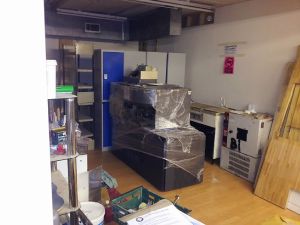Difference between revisions of "Flow Cytometer"
m |
m |
||
| Line 5: | Line 5: | ||
| category = Equipment <!-- Main category. Please leave alone to keep item in this category --> | | category = Equipment <!-- Main category. Please leave alone to keep item in this category --> | ||
| subcat = Biohacking<!-- Sub-category if one exists. Please check main listing to see other categories contained within the main one --> | | subcat = Biohacking<!-- Sub-category if one exists. Please check main listing to see other categories contained within the main one --> | ||
| − | | status = | + | | status = Scrapped<!-- Set to one of; Good working order, Faulty, Out of order, Under construction, Out of consumables, Scrapped, or Unknown --> |
| consumables = Sheath Solution, Cleaning fluid, sample tubes<!-- Any items used up in normal operation, such as; ink, paper, saw-blades, cutting disks, oil, etc.. --> | | consumables = Sheath Solution, Cleaning fluid, sample tubes<!-- Any items used up in normal operation, such as; ink, paper, saw-blades, cutting disks, oil, etc.. --> | ||
| accessories = Unknown <!-- Any items associated with the equipment but not consumable, such as; drill bits, safety gloves, goggles, etc.. --> | | accessories = Unknown <!-- Any items associated with the equipment but not consumable, such as; drill bits, safety gloves, goggles, etc.. --> | ||
| Line 18: | Line 18: | ||
}} | }} | ||
| + | <s>Imperial College donated a Flow Cytometer. It was donated as working, but in need of repair. However there is a lot of damage due to corrosion, which might be impossible to fix for a reasonable amount of time and money.</s> | ||
| − | + | <s>'''Status:''' It's sustained damage to the sampling area, and we are missing some bits. Repairing is likely to be very $$$, so we are planning to dismantle it and use the optics and lasers on other projects.</s> | |
| + | |||
| + | '''Status:''' The machine was too expensive to repair, and was too large to store and therefore has been scrapped. Several of the parts have been incorporated into other projects, or have been ebayed. | ||
The unit is too large to be stored in the biolab (1.8m X 0.8m = 1.44 square meters of floor space) and was previously moved to storage while we worked on it. | The unit is too large to be stored in the biolab (1.8m X 0.8m = 1.44 square meters of floor space) and was previously moved to storage while we worked on it. | ||
| − | + | ||
There are a number of large external units some of which are for providing power and cooling to the large laser. | There are a number of large external units some of which are for providing power and cooling to the large laser. | ||
Revision as of 16:09, 2 December 2014
Imperial College donated a Flow Cytometer. It was donated as working, but in need of repair. However there is a lot of damage due to corrosion, which might be impossible to fix for a reasonable amount of time and money.
Status: It's sustained damage to the sampling area, and we are missing some bits. Repairing is likely to be very $$$, so we are planning to dismantle it and use the optics and lasers on other projects.
Status: The machine was too expensive to repair, and was too large to store and therefore has been scrapped. Several of the parts have been incorporated into other projects, or have been ebayed.
The unit is too large to be stored in the biolab (1.8m X 0.8m = 1.44 square meters of floor space) and was previously moved to storage while we worked on it.
There are a number of large external units some of which are for providing power and cooling to the large laser.
There is a good description of how a flow cytometer works here; http://media.invitrogen.com.edgesuite.net/tutorials/4Intro_Flow/player.html
The machine requires a dust free environment due to it's use of lasers and optics.
I am currently looking to obtain a copy of the service manual.
Educationz
Harvard University extension school course on microfluidics, course notes
http://isites.harvard.edu/icb/icb.do?keyword=k41912&pageid=icb.page213804
Caltech course notes on microfluidics
http://thesis.library.caltech.edu/4796/3/02_Chapter_2.pdf
Cornell book on microfluidics
http://www.kirbyresearch.com/index.cfm/wrap/textbook/microfluidicsnanofluidics.html
Flow cytometry tutorial
This is a AV presentation describing the basics of the technology;
http://media.invitrogen.com.edgesuite.net/tutorials/4Intro_Flow/player.html
Practical Flow cytometry
This is an online version of the bible of Flow cytometry (Shapiro 2003)
http://www.coulterflow.com/bciflow/practical/book/index.html
Dako - flow cytometry
http://www.dako.com/08065_15dec05_guide_to_flow_cytometry.pdf
Microfluidics Links
Introduction to fluidics
